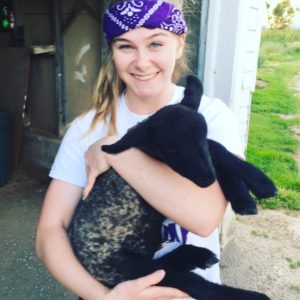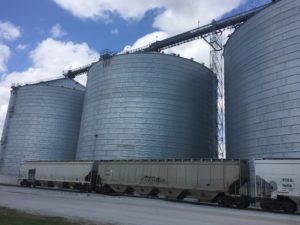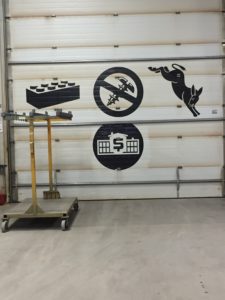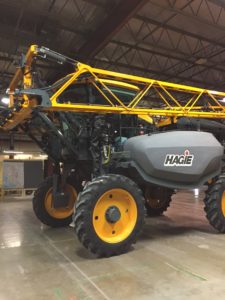Our last Saturday in Iowa was one of our least busy days. Even though it wasn’t as busy, it still started bright and early. Since “Sophia” is still out of commission, we were greeted by the twins and H-N at 6:45 so we could to make it to Morris’s for our 7:00 breakfast. After a hearty breakfast, we discussed our plans for the day and set off for the short drive to the Ames Farmers Market. When we arrived at 8:30, there weren’t many people there. The small market was only about three or four blocks in total, but people were really enjoying themselves. The vendors sold everything from produce to soap and even some even sold clothes. They also had a petting zoo for the kids. The coolest part was seeing some local farmers we had met with set up. Tom and Kevin both had booths and were selling at a high clip. After going to both markets, it would be interesting to ask Kevin how much he made in Ames compared to what his wife made in Des Moines.
Once we finished our short time in Ames, we made a quick 30-minute drive to the Des Moines Downtown Farmers Market. The hardest part of the day was trying to find a parking spot. Most parking garages are just a little too small for our van, which we learned the hard way. Once we found a spot, we ran into the farmers market and had a few hours to look around. The Des Moines Farmers Market is huge. It probably took up close 10 blocks and we might have walked close to a mile to see it all. Some of the same vendors from Ames, like Kevin’s Lost Lake Farm and a mini doughnut stand were in Des Moines. I spent most of the time walking around with Josh and Jessie. Since we were itching to buy something, we started off by buying some kettle corn. This way, we could eat a snack while looking at other food. Because of the impending weather, the farmers market closed at 11:30. So, we had to go through quick. Josh, Jessie, and I saw everything. We even bought some stuff goodies. Jessie and I both bought some Jelly from Blue Gate Farms, the site of the Practical Farmers of Iowa Field Day we attended, and Josh bought a necklace made from local stone. Most of the stands seemed like they were selling all locally grown products. However, a few stands were selling out of place fruits like watermelon and avocado. As we’ve learned, they could have been made in a hoop house, but they also could have been bought at a store in hopes of turning an easy profit.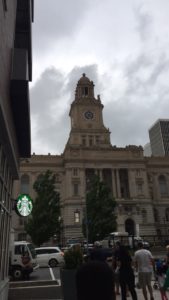
When the rain drove us away, we returned to Morris’s for a break. Because of the weather, we couldn’t work in the Fiscus Garden like we had planned. So, while some people napped, Reid, Sophie, Josh, Jessie, and I broke out the Wizard of Oz Monopoly board. Although I feel like some friendships were ended, it was an incredibly fun game that almost everyone enjoyed. After the three-hour marathon game, I decided to take a walk through Morris’s muddy corn field. Although my feet are still dirty after three showers, I really enjoyed the peace that I got from walking down the rows. I even picked up some rocks. Once I was back inside and washed up, it was time for dinner. We had tater tot casserole and Morris’s world famous death by chocolate for dessert. Although we hadn’t eaten since about 11, we took our time and savored every bite.
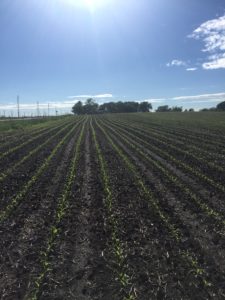
After dinner, we made our way to the Neubauer Farm and watched the movie King Corn. King Corn is a documentary about two recent college graduates who go to Iowa to plant one acre of corn. Their goal is to watch the corn from the time it is planted to wherever it ends up. However, the film showed this was impossible. Once the corn is sent to an elevator, it gets combined with the thousands of bushels already there. There were a few really interesting things I picked up from King Corn. First, we are basically made of corn. Almost every piece of food we eat can be traced back to corn. Therefore, it can almost all be traced back to Iowa. Whether it is a Coke sweetened with high-fructose corn syrup or a piece of steak that was taken from a corn-fed cow, corn is everywhere. Even when we looked at basic kitchen items at Morris’s, most them used some type of corn product. Second, the movie showed it is almost impossible to make money in farming without government subsidies. The two film-makers made about $28 from government subsidies in 2005. Without these subsidies, they would have lost $18 overall.
In my opinion, the most important takeaway is how important corn truly is to our society. Most of the corn that is grown can’t be eaten by humans. It must go through some sort of processing to make it edible. Although we do get cheap food, it is mostly composed of cheap ingredients. Cows shouldn’t be fed corn, they should be fed grass. The beef we get from corn-fed cows isn’t as good beef from grass-fed cows. According to the film, we are the first generation that has a life expectancy shorter than their parents. This could very easily be attributed to our diet. They do not have the variety they did in our parents’ generation. Also, processed foods play a bigger role than ever before. If we want to see change in our health, quality of life, and our environment, we should look carefully at the quality and quantity of corn being grown.




